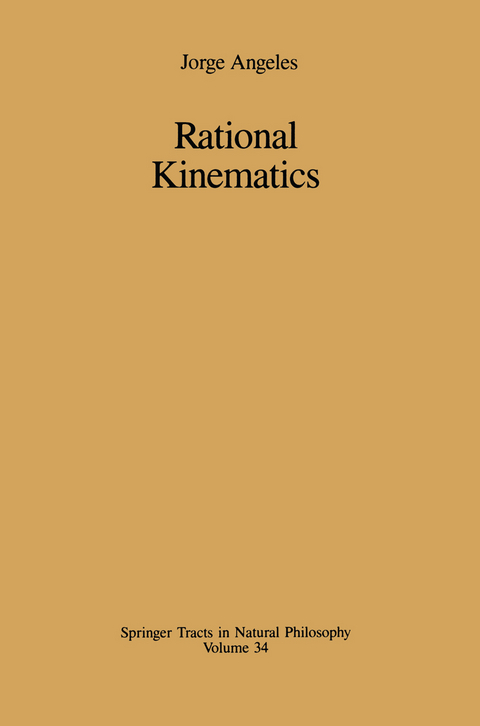
Rational Kinematics
Springer-Verlag New York Inc.
978-0-387-96813-1 (ISBN)
- Titel z.Zt. nicht lieferbar
- Versandkostenfrei innerhalb Deutschlands
- Auch auf Rechnung
- Verfügbarkeit in der Filiale vor Ort prüfen
- Artikel merken
A rational study of kinematics is a treatment of the subject based on invariants, i.e., quantities that remain essentially unchanged under a change of observer. An observer is understood to be a reference frame supplied with a clock (Truesdell 1966). This study will therefore include an introduction to invariants. The language of these is tensor analysis and multilinear algebra, both of which share many isomorphic relations, These subjects are treated in full detail in Ericksen (1960) and Bowen and Wang (1976), and hence will not be included here. Only a short account of notation and definitions will be presented. Moreover, definitions and basic concepts pertaining to the kinematics of rigid bodies will be also included. Although the kinematics of rigid bodies can be regarded as a particular case of the kinematics of continua, the former deserves attention on its own merits for several reasons. One of these is that it describes locally the motions undergone by continua. Another reason is that a whole area of mechanics, known as classical dynamics, is the study of the motions undergone by particles, rigid bodies, and systems thereof.
1 Preliminary Notions.- 1.1 Introduction.- 1.2 On Notation and Basic Definitions.- 1.3 Further Definitions.- 1.4 Invariance.- 1.5 Generalized Inverses.- 2 Displacement of a Rigid Body.- 2.1 Introduction.- 2.2 Rotation of a Rigid Body About a Fixed Point.- 2.3 The Theorem of Euler.- 2.4 The Rotation Tensor.- 2.5 General Motion of a Rigid Body. The Pose and the Screw of a Rigid Body.- 2.6 Theorems About the General Motion of a Rigid Body.- 2.7 Compatibility Equations.- 3 Velocity Analysis of Rigid-Body Motions.- 3.1 Introduction.- 3.2 Motion of a Rigid Body About a Fixed Point.- 3.3 General Instantaneous Motion of a Rigid Body. The Twist of a Rigid Body.- 3.4 Further Results on the Velocity Distribution Throughout a Rigid Body.- 3.5 Compatibility Equations.- 4 Acceleration Analysis of Rigid-Body Motions.- 4.1 Introduction.- 4.2 Acceleration Field of a Body Moving About a Fixed Point.- 4.3 Acceleration Field of a Rigid Body Under General Motion.- 4.4 Change of Observer. Coriolis’ Theorem.- 4.5 Determination of Angular Acceleration. Compatibility Equations.- 5 Kinematic Chains.- 5.1 Introduction.- 5.2 Kinematic Pairs. Classification.- 5.3 Simple Kinematic Chains. Degree of Freedom by Groups of Motion.- 5.4 The Twist of a Link and the Jacobian of a Simple Kinematic Chain.- 5.5 The Condition Number of a Kinematic Chain. Isotropy.- 5.6 Complex Kinematic Chains. An Overview.- 5.7 The Jacobian of a Multiple-Closed-Loop Kinematic Chain. Degree of Freedom.- 5.8 Holonomic and Nonholonomic Constraints.- 5.9 Analysis of Kinematic Chains.- 5.10 Synthesis of Kinematic Chains.- References.
| Erscheint lt. Verlag | 20.3.1989 |
|---|---|
| Reihe/Serie | Springer Tracts in Natural Philosophy ; 34 |
| Zusatzinfo | XII, 121 p. |
| Verlagsort | New York, NY |
| Sprache | englisch |
| Themenwelt | Mathematik / Informatik ► Mathematik ► Angewandte Mathematik |
| Naturwissenschaften ► Chemie ► Physikalische Chemie | |
| Naturwissenschaften ► Physik / Astronomie ► Mechanik | |
| ISBN-10 | 0-387-96813-X / 038796813X |
| ISBN-13 | 978-0-387-96813-1 / 9780387968131 |
| Zustand | Neuware |
| Haben Sie eine Frage zum Produkt? |
aus dem Bereich


